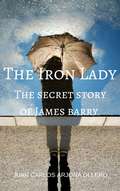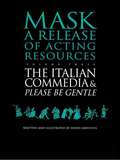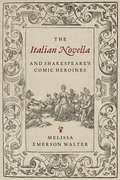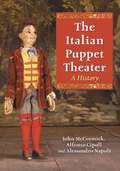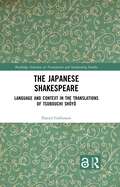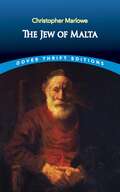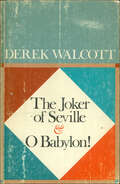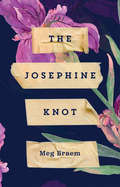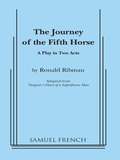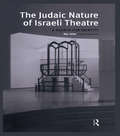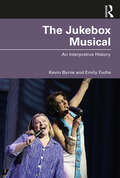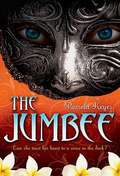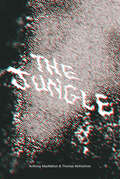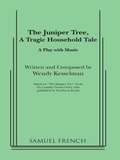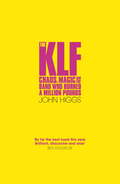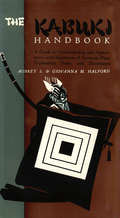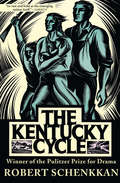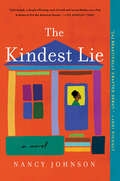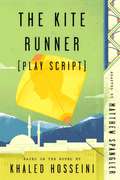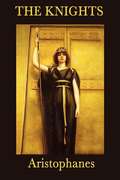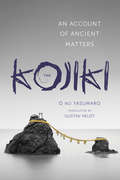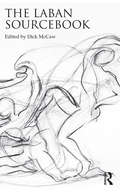- Table View
- List View
The Iron Lady (The secret story of James barry)
by Juan Carlos Arjona Ollero Claudia Elena ArredondoThis historical novel talks about Margaret Ann Bulkley, most famously known as James Barry, a doctor who served the British flag and for it sacrificed herself to become a man and be able to follow her dreams in pursuit of an education which was in fact forbidden to her gender.
The Italian Commedia and Please be Gentle
by David GriffithsFocusing on Commedia Dell'Arte, this work provides a historical and critical commentary of the Commedia. It highlights common factors between this genre and that of the Japanese Noh theatre. The author proposes six similarities: characters familiar to their audience and masked, minimal properties and scenery with the focus on the actor, the "families" of performers, a sharp mind as well as an agile body, a professional living on these skills and patronage, and a knowledgeable audience. Complementing this book is the play "Please Be Gentle" which explores the various tricks and devices of Commedia Dell'Arte acting.
The Italian Novella and Shakespeare’s Comic Heroines
by Melissa WalterUsing a comparative, feminist approach informed by English and Italian literary and theatre studies, this book investigates connections between Shakespearean comedy and the Italian novella tradition. Shakespeare’s comedies adapted the styles of wit, character types, motifs, plots, and other narrative elements of the novella tradition for the Elizabethan and Jacobean stage, and they investigated social norms and roles through a conversation carried out in narrative and drama. Arguing that Shakespeare’s comedies register the playwright’s reading of the novella tradition within the collaborative playmaking context of the early modern theatre, this book demonstrates how the comic vision of these plays increasingly valued women’s authority and consent in the comic conclusion. The representation of female characters in novella collections is complex and paradoxical, as the stories portray women not only in the roles of witty plotters and storytellers but also through a multifaceted poetics of enclosed spaces – including trunks, chests, caskets, graves, cups, and beds. The relatively open-ended rhetorical situation of early modern English theatre and the dialogic form and narrative material available in the novella tradition combine to help create the complex female characters in Shakespeare’s plays and a new form of English comedy.
The Italian Puppet Theater: A History
by John Mccormick Alessandro Napoli Alfonso CipollaThis is the first full-length, English language study of Italian puppetry. Chapters describe Italy's rich puppet theater tradition through the end of the eighteenth century; the golden age of glove puppets, marionettes and pupi; commedia dell'arte and the puppet stage; the evolution of repertoires; music and spectacle; and changes during the twentieth century. Concluding chapters offer in-depth studies of two marionette companies, Turin's Lupi and Catania's Fratelli Napoli.
The Japanese Shakespeare: Language and Context in the Translations of Tsubouchi Shōyō (Routledge Advances in Translation and Interpreting Studies)
by Daniel GallimoreOffering the first book-length study in English on Tsubouchi and Shakespeare, Gallimore offers an overview of the theory and practice of Tsubouchi’s Shakespeare translation and argues for Tsubouchi’s place as "the Japanese Shakespeare."Shakespeare translation is one of the achievements of modern Japanese culture, and no one is more associated with that achievement than the writer and scholar Tsubouchi Shōyō (1859–1935). This book looks at how Tsubouchi received Shakespeare in the context of his native literature and his strategies for bridging the gaps between Shakespeare’s rhetoric and his developing language. Offering a significant contribution to the field of global Shakespeare and literary translation, Gallimore explores dominant stylistic features of the early twentieth-century Shakespeare translations of Tsubouchi and analyses the translations within larger linguistic, historical, and cultural traditions in local Japanese, universal Chinese, and spiritual Western elements.This book will appeal to any student, researcher, or scholar of literary translation, particularly those interested in the complexities of Shakespeare in translation and Japanese language, culture, and society.Chapters 2 and 3 of this book are freely available as a downloadable Open Access PDF at http://www.taylorfrancis.com under a Creative Commons [Attribution-Non Commercial-No Derivatives (CC-BY-NC-ND)] 4.0 license.
The Jew of Malta: With Related Texts (Dover Thrift Editions)
by Christopher MarloweThe spirit of Machiavelli presides over The Jew of Malta, in which the title character relentlessly plots to maintain and extend his political influence and wealth. A paragon of remorseless evil, Barabas befriends and betrays the Turkish invaders and native Maltese alike, incites a duel between the suitors for his daughter's hand, and takes lethal revenge upon a convent of nuns.Both tragedy and farce, this masterpiece of Elizabethan theater reflects the social and political complexities of its age. Christopher Marlowe's dramatic hybrid resonates with racial tension, religious conflict, and political intrigue -- all of which abounded in 16th-century England. The playwright, who infused each one of his plays with cynical humor and a dark world view, draws upon stereotypes of Muslim and Christian as well as Jewish characters to cast an ironic perspective on all religious beliefs.The immediate success of The Jew of Malta on the Elizabethan stage is presumed to have influenced Marlowe's colleague, William Shakespeare, to draw upon the same source material for The Merchant of Venice. The character of Barabas is the prototype for the well-known Shylock, and this drama of his villainy remains a satirical gem in its own right.
The Joker of Seville & O Babylon!
by Derek WalcottSince 1959, Derek Walcott has directed and written for the Trinidad Theatre Workshop. The Joker of Seville, a comedy based on Tirso de Molina's El Burlador de Sevilla, was commissioned by England's Royal Shakespeare Company. Walcott's sensitivity to the pacing, meter, and lyricism of the original makes his first attempt at adaptation an extraordinary accomplishment. O Babylon! brings life the Rastafarian sect in Jamaica, which grew during Marcus Garvey's exile to that country and has recently been popularized through the lyrics of reggae music.Mr. Walcott's plays have been produced by the New York Shakespeare Festival, the Mark Taper Forum in Los Angeles, and the Negro Ensemble Company. Dream on Monkey Mountain, the title play of his earlier collection, won the Obie Award for a Distringuished Foreign Play when produced in New York in 1971. It was deemed "a masterpiece" by Edith Oliver in The New Yorker. "Dream on Monkey Mountain," she wrote, "is a poem in dramatic form or a drama in poetry, and poetry is rare in the modern theatre. Every line of it plays....there is a sound psychological basis for every action and emotion."
The Josephine Knot
by Amiel Gladstone Meg BraemAfter Samantha’s baba dies, her fractured family is summoned to pick through the house full of belongings and trash, leaving taped notes on whatever they want to take. Between old napkins, a closet full of ketchup packets, and a freezer full of rotting meat are gems like a grandfather clock and plastic deer statuettes that hold more sentiment. While her father David sifts through his own memories, all Samantha wants is to find a simple object that could represent her place in the family. When other family members arrive, tug of wars and passive-aggressive conversations commence. In a house full of junk and sadness, it comes down to Samantha and David to find a new way to fit together.
The Journey of Fifth Horse
by Ronald RibmanA reader in a publishing house is given a diary to take home and read overnight. This sets three worlds spinning: the reader's dream world, the real world and the world of the diarist. In his dreams the reader is to marry the owner's daughter while his lady is eager to wed and bed him. In reality, he proposes to the landlady and is promptly scorned. The diarist loved a girl who fell victim to a dashing cossack and was left pregnant when his regiment moved on. The diarist is scorned for having provoked a duel, and the girl will not even have him as a foster father for the child.
The Judaic Nature of Israeli Theatre: A Search for Identity (Contemporary Theatre Studies #Vol. 31.)
by Dan UrianTheatre has, since the time of the Jewish Enlightenment, served the secular community in its conflict with the religious. This book surveys the secular-religious rift and then describes the enhanced concern of the secular community in Israel for its own Jewishness and its expression in the theatre - especially following the 1967 War. It then moves on to a specific study of the play Bruira and finally reviews the phenomenon of the return to Orthodox Judaism by secular individuals.
The Jukebox Musical: An Interpretive History
by Kevin Byrne Emily FuchsThis is a comprehensive guide to the unique genre of the jukebox musical, delving into its history to explain why these musicals have quickly become beloved for multiple generations of theatergoers and practitioners. Providing a concise exploration of the three main categories of the jukebox musical—biographical, genre-specific, and artist catalog—this text is perfect for those wishing to learn more about this relatively recent and unique genre of theater. It identifies the dramaturgical needs that arise in these productions and explains how certain works become critical darlings or fan favorites. How much information needs to be conveyed through song and how much can be left up to interpretation by the audience? What kinds of changes occur when a repertoire of songs is reimagined for the stage? In addition to these insightful explorations, it also reveals how creative teams tackle the unique challenge of weaving together plot and song in order to convey meaning, emotion, excitement, and beauty in these increasingly popular forms of theater. The Jukebox Musical: An Interpretive History is written for students, performers, and musical theater enthusiasts alike: this is the ideal introduction to one of the twnty-first century's most popular and successful stage genres.
The Jumbee
by Pamela KeyesWhen Esti Legard starts theater school on Cariba, she's determined to step out of the shadow of her late father, a famous Shakespearean actor. But on an island rife with superstition, Esti can't escape the darkness. In the black of the theater, an alluring phantom voice-known only as Alan-becomes her brilliant drama tutor, while in the light of day Esti struggles to resist her magnetic attraction to Rafe, the local bad boy. Toppled sets, frightening rumors of jumbee ghosts, and brewing tropical storms culminate in a tantalizingly spooky finale where romance sizzles and truths are unmasked. Laced with eerie mystery and the lush scenery of the West Indies, this modern Phantom is perfect for readers who like their love stories served with spine-tingling suspense.
The Jungle
by Anthony MacMahon Thomas McKechnieInspired by Upton Sinclair’s novel The Jungle.This play paints a stark and realistic portrait of what it’s like to live in cities such as Toronto currently, especially as a young person battling late-stage capitalism.First produced by Tarragon Theatre, Toronto, in October 2019
The Juniper Tree, A Tragic Household Tale
by Wendy KesselmanPlay with music / 1 m., 1 f. plus small on stage combo and f. narrator/singer. / Exterior / "Wendy Kesselman has taken 'The Juniper Tree' (the Brothers Grimm story), and turned it into a haunting little musical in the shape of a ballad. . . . The events- including murder and cannibalism- are gruesome, but the telling has a childlike Story Theatre quality... as exemplified by her ballad of The Juniper Tree and her earlier play My Sister in This House, the versatile Miss Kesselman has a fabulist's view of guilt and retribution." N.Y. Times.
The KLF: Chaos, Magic and the Band who Burned a Million Pounds
by John Higgs'The best non-fiction book I've ever read. It's magical. Stunning' Dan Schreiber, No Such Thing As a Fish'A pop biography for people who don't read pop biographies' Dorian Lynskey, Guardian'Brilliant, discursive and wise' Ben Goldacre'Utterly irresistible and totally brilliant' The Quietus'A thing of endlessly fascinating, utterly demented genius' Alexis PetridisTHE STRANGE TALE OF THE DEATH, LIFE AND LEGACY OF THE HUGELY SUCCESSFUL BAND.They were the bestselling singles band in the world. They had awards, credibility, commercial success and creative freedom. Then they deleted their records, erased themselves from musical history and burnt their last million pounds in a boathouse on the Isle of Jura. And they couldn't say why.This is not just the story of The KLF. It is a book about Carl Jung, Alan Moore, Robert Anton Wilson, Ken Campbell, Dada, Situationism, Discordianism, magic, chaos, punk, rave, the alchemical symbolism of Doctor Who and the special power of the number 23.Wildly unauthorised and unlike any other music biography, THE KLF is a trawl through chaos on the trail of a beautiful, accidental mythology.
The Kabuki Handbook
by Giovanna M. Halford Aubrey S. HalfordKabuki has been described as "in the main, the finest theatre art in the world," and its ever-growing popularity both in Japan and abroad bears witness to its tremendous dramatic effectiveness. The fact that many persons tend to regard it as mere spectacle, thus missing the greater part of its moving appeal, has been due to the lack of any key to the intricacies of its plots and its unfamiliar stage conventions. Here at last is a genuine key, one which opens wide vistas of understanding and appreciation. Included here are lucid synopses and crystal-clear explanations of the hundred odd plays which form the backbone of the classical Kabuki repertoire and constitute over twice that many individual program items. Equally as valuable as the synopses are the informative and entertaining Notes explaining the many points that have proved perplexing to the non-Japanese spectator. Both synopses and notes are provided with a careful system of cross references and an indispensable index, all making for ready use and saving the spectator from "dwelling so much on some minor, but incomprehensible, point that the thread of the drama is lost."
The Kabuki Handbook
by Giovanna M. Halford Aubrey S. HalfordKabuki has been described as "in the main, the finest theatre art in the world," and its ever-growing popularity both in Japan and abroad bears witness to its tremendous dramatic effectiveness. The fact that many persons tend to regard it as mere spectacle, thus missing the greater part of its moving appeal, has been due to the lack of any key to the intricacies of its plots and its unfamiliar stage conventions. Here at last is a genuine key, one which opens wide vistas of understanding and appreciation. Included here are lucid synopses and crystal-clear explanations of the hundred odd plays which form the backbone of the classical Kabuki repertoire and constitute over twice that many individual program items. Equally as valuable as the synopses are the informative and entertaining Notes explaining the many points that have proved perplexing to the non-Japanese spectator. Both synopses and notes are provided with a careful system of cross references and an indispensable index, all making for ready use and saving the spectator from "dwelling so much on some minor, but incomprehensible, point that the thread of the drama is lost."
The Kabuki Handbook
by Giovanna M. Halford Aubrey S. HalfordKabuki has been described as "in the main, the finest theatre art in the world," and its ever-growing popularity both in Japan and abroad bears witness to its tremendous dramatic effectiveness. The fact that many persons tend to regard it as mere spectacle, thus missing the greater part of its moving appeal, has been due to the lack of any key to the intricacies of its plots and its unfamiliar stage conventions. Here at last is a genuine key, one which opens wide vistas of understanding and appreciation. Included here are lucid synopses and crystal-clear explanations of the hundred odd plays which form the backbone of the classical Kabuki repertoire and constitute over twice that many individual program items. Equally as valuable as the synopses are the informative and entertaining Notes explaining the many points that have proved perplexing to the non-Japanese spectator. Both synopses and notes are provided with a careful system of cross references and an indispensable index, all making for ready use and saving the spectator from "dwelling so much on some minor, but incomprehensible, point that the thread of the drama is lost."
The Kentucky Cycle
by Robert SchenkkanThe Pulitzer Prize–winning cycle of one-act plays spanning two centuries of American history: “hauntingly memorable [with a] poetic impulse” (Time). One of the most important contemporary works of political theater, The Kentucky Cycle was awarded the 1992 Pulitzer Prize for its astute and dramatically epic investigation of the brutal birth of America. Set in the Appalachian Mountains and spanning seven generations—from 1775 to 1975—this saga of rural Kentucky digs beneath our American mythology to confront the truth of our national history. It is the story of three families whose lives are irrevocably intertwined as they struggle for control over a portion of the Cumberland Plateau. From the darker realities of our pioneer heritage to the bloody lessons of the Civil War, and from the Unionization of coal miners to the harsh environmental legacy of strip mining, this fascinating work chronicles the lives of ordinary people struggling to find a better place for themselves in an unpredictable world. “Serious drama with a dark center . . . an epic.” —The New Yorker “Riveting theater . . . [a] monumental work.” —Los Angeles Times
The Kindest Lie: A Novel
by Nancy JohnsonRecommended by O Magazine * GMA * Elle * Marie Claire * Good Housekeeping * NBC News * Shondaland * Chicago Tribune * Woman's Day * Refinery 29 * Bustle * The Millions * New York Post * Parade * Hello! Magazine * PopSugar * and more!“The Kindest Lie is a deep dive into how we define family, what it means to be a mother, and what it means to grow up Black...beautifully crafted.” —JODI PICOULT"A fantastic story...well-written, timely, and oh-so-memorable."—Good Morning America“The Kindest Lie is a layered, complex exploration of race and class." —The Washington PostEvery family has its secrets...It’s 2008, and the inauguration of President Barack Obama ushers in a new kind of hope. In Chicago, Ruth Tuttle, an Ivy-League educated Black engineer, is married to a kind and successful man. He’s eager to start a family, but Ruth is uncertain. She has never gotten over the baby she gave birth to—and was forced to leave behind—when she was a teenager. She had promised her family she’d never look back, but Ruth knows that to move forward, she must make peace with the past.Returning home, Ruth discovers the Indiana factory town of her youth is plagued by unemployment, racism, and despair. As she begins digging into the past, she unexpectedly befriends Midnight, a young white boy who is also adrift and looking for connection. Just as Ruth is about to uncover a burning secret her family desperately wants to keep hidden, a heart-stopping incident strains the town’s already searing racial tensions, sending Ruth and Midnight on a collision course that could upend both their lives.Powerful and unforgettable, The Kindest Lie is the story of an American family and reveals the secrets we keep and the promises we make to protect one another.
The Kindness of Strangers: The Life of Tennessee Williams
by Donald SpotoThis is a biography of America's greatest playright. Spoto tells of Williams's troubled childhood, his growing interest in writing, his output of plays with examples of critical notices, and his troubled private life. Williams was the living definition of prolific, where creative writing is concerned, though he was a victim of almost chronic depression.
The Kite Runner (Play Script): Based on the novel by Khaled Hosseini
by Matthew SpanglerThe script for the stage production of Khaled Hosseini's first and internationally bestselling novel, The Kite Runner, as adapted by playwright Matthew Spangler. The unforgettable, heartbreaking story of the unlikely friendship between a wealthy boy and the son of his father's servant, The Kite Runner is a beautifully crafted novel set in a country that is in the process of being destroyed. Now adapted for the stage, the story is about the power of reading, the price of betrayal, and the possibility of redemption, and is an exploration of the influence of fathers over sons--their love, their sacrifices, their lies.A sweeping saga of family, love, and friendship told against the devastating backdrop of the history of Afghanistan over the last thirty years, The Kite Runner is an unusual and powerful story that has become a beloved, one-of-a-kind classic.This adaptation was first performed at Wyndham's Theatre, London, in December 2016.
The Knights
by AristophanesIf the American Editor of this little volume (which is sent forth as a test of the character of American learning) deemed it either expedient or necessary to expatiate upon the merits of an author so celebrated and gifted as A ristophanes, he might extend his eulogia beyond the patient perusal of the moderns. The eloquent and erudite preliminary discourse by the accomplished translator, however, anticipates the remarks which otherwise would be expanded. No satirist, ancient or modern, ever enjoyed the deserved reputation of A ristophanes, and no one ever depicted, in colors so vivid and unfading, the essential and peculiar characteristics of democracy. As he lived under the dominion of the Universal People, he thoroughly understood the qualities of the democrats whom he has ridiculed and immortalized; and he never shrunk, when occasion demanded, from the exposure of flagrant abuses. Therefore, we commend, earnestly commend the perusal of this volume to our literary countrymen: and if the reception of this limited edition of a single comedy shall justify the editor in the more enlarged republication of all the works of A ristophanes, he will rejoice in the opportunity, thus afforded, of instructing and enlightening his countrymen.
The Kojiki
by Gustav HeldtChronicles the mythical origins of Japan's islands and their ruling dynasty through a diverse array of genealogies, tales, and songs
The Laban Sourcebook
by Dick McCawRudolf Laban (1879 – 1958) was a pioneer in dance and movement, who found an extraordinary range of application for his ideas; from industry to drama, education and therapy. Laban believed that you can understand about human beings by observing how they move, and devised two complimentary methods of notating the shape and quality of movements. The Laban Sourcebook offers a comprehensive account of Laban’s writings. It includes extracts from his five books in English and from his four works in German, written in the 1920s and translated here for the first time. This book draws on archival research in England and Germany to chart the development of Laban’s groundbreaking ideas through a variety of documents, including letters, articles, transcripts of interviews, and his unpublished Effort and Recovery. It covers: The beginning of his career in Germany and Switzerland in the 1910s. His astonishing rise to fame in Germany in the 1920s as a dance teacher, choreographer and creator of public dance events. Following his move to England in 1938, the application of his ideas to drama, education, industry, and therapy. Each extract has a short preface providing contextual background, and highlighting and explaining key terms. Passages have been selected and are introduced by many of the world’s leading Laban scholars.
